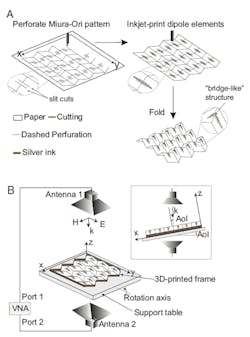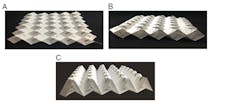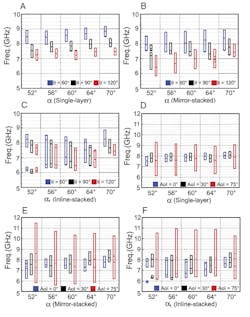Shape-Shifting Origami Surface Yields Dynamically Tunable RF Filter
Engineers know the vital role of filters and ubiquitous presence in systems spanning the electromagnetic spectrum of dc to GHz RF and even into the optical zone. As the use of multiple bands grows—especially in a single system—the multiplicity of these filters absorbs more space and adds cost.
The solution, of course, is an electrically tunable filter, an approach that’s been implemented with varying success. Attempts have included using electronic potentiometers at lower frequencies to methods that employ voltage-variable diodes (commonly called varicap diodes or simply varicaps) and tunable resonators at higher frequencies, as well as adjustable optical cavities.
But it’s also possible to make an electronic filter based on mechanical dimensions, of course (such as crystal filters), and it would be even better if that approach could also be made tunable. That’s what a team at the Georgia Institute of Technology (Georgia Tech) has done, building on work done using spatial filers comprised of frequency-selective surfaces (FSSs). They combined additive manufacturing (AM) and origami principles to create tunable filters that can be reconfigured dynamically from a compact, folded form to a larger, partially or fully unfolded configuration (Fig. 1).
1. Schematics of the general fabrication process and experimental setup: Schematics of the fabrication process of each Miura-FSS layer, which consists of the perforation of the modified Miura-Ori pattern, inkjet printing of the dipole elements, and manual folding of the pattern (a). Schematics of the experimental characterization setup (b). The op box shows a side (“plane of incidence”) view of the setup, where angle of incidence (AoI) represents how much the support table was tilted, reflecting the relative angle between the incident waves and the normal to the FSS structure plane. (Source: Georgia Institute of Technology)
(Note that FSSs themselves are not new; they’re used in RF/microwave surfaces to reduce radar cross section (RCS), among other roles. Typically, these FSS structures are fabricated on a thin substrate sheet with an arrangement that can provide bandpass or band-reject characteristics, but with fixed tuning.)
This may seem an obvious idea based on a simple concept, but creative thinking and innovation is needed to implement it. The process began with a special printer that scored the substrate paper, enabling it to be folded. An inkjet printer then added silver ink on both sides of the scored perforations to yield sets of dipole-like elements needed for the RF filtering. One potential problem is that dipoles could break or snap along the fold lines, so they suspended the “inking” at each crossover before continuing onto the other side. Finally, they formed a bridge with a gradual bend via a separate step.
The next issue was what fold pattern to use. The team reached into the world of origami research for a well-known pattern called Miura-Ori (see The Miura-Ori Fold at Natural Origami), which can expand to a flat surface and contracts like an accordion, but yields a minimum-volume package. The filter can even be folded up completely for minimum volume, then extended as needed for a spacecraft, for example.
The Georgia Tech effort went a step further and did not end with this basic filter. By building multilayer or inline-stacked Miura-Ori FSS arrangements, they were able to create higher-order filters as well as filters with different bandwidths (Fig. 2).
2. Design, assembly, and response of a proof-of-concept origami FSS assemblage is shown with dipole elements of dimension 20 × 2 mm. The prototypes illustrated are Miura-FSS (a), mirror-stacked Miura-FSS (b), and inline-stacked Miura-FSS (c). (Source: Georgia Institute of Technology)
This origami pattern was used to develop FSS filters with the resonant dipole elements located along the fold lines. Since the electrical length of the various dipole elements changes as the Miura-Ori origami patter is folded, the tuned resonant frequency of the filter also changes.
“The Miura-Ori pattern has an infinite number of possible positions along its range of extension from fully compressed to fully expanded,” said Glaucio Paulino, the Raymond Allen Jones Chair of Engineering and a professor in the Georgia Tech School of Civil and Environmental Engineering. “A spatial filter made in this fashion can achieve similar versatility, changing which frequency it blocks as the filter is compressed or expanded.”
The simulation results were verified by a bistatic measurement setup consisting of two broadband horn antennas placed in the line of sight to each other with the fabricated Miura-FSS structure placed in the middle. The results for various structures, configurations, and incidence angles are shown in Figure 3.
3. The internal lines in this simulated response of the Miura-Ori-based FSS represent the resonant frequency, and the top and bottom lines represent the cutoff frequencies at −10 dB. Shown is the response of the FSS structures with distinct panel angles α = 52°, 56°, 60°, 64°, 70° (in the case of inline stacking, α = αt , i.e., the angle α for the top layer. The a, b, and c images reveal a specific AoI = 0° and distinct folding angles α = 60°, 90°, 120° for single-layer, mirror-stacked, and inline-stacked Miura-FSS, respectively. The d, e, and f images reveal a specific folding angle α = 90° and distinct AoI = 0°, 30°, 75° considering single-layer, mirror-stacked, and inline-stacked Miura-FSS, respectively. (Source: Georgia Institute of Technology)
This research was supported by the National Science Foundation, the U.S. Department of Defense, and the Semiconductor Research Corporation. The academic paper “Continuous-range tunable multilayer frequency-selective surfaces using origami and inkjet printing” was published in the journal Proceedings of the National Academy of Sciences with supplemental information and videos here. A less-technical overview at Georgia Tech’s Research Horizons publication can be found here.
About the Author

Bill Schweber
Contributing Editor
Bill Schweber is an electronics engineer who has written three textbooks on electronic communications systems, as well as hundreds of technical articles, opinion columns, and product features. In past roles, he worked as a technical website manager for multiple topic-specific sites for EE Times, as well as both the Executive Editor and Analog Editor at EDN.
At Analog Devices Inc., Bill was in marketing communications (public relations). As a result, he has been on both sides of the technical PR function, presenting company products, stories, and messages to the media and also as the recipient of these.
Prior to the MarCom role at Analog, Bill was associate editor of their respected technical journal and worked in their product marketing and applications engineering groups. Before those roles, he was at Instron Corp., doing hands-on analog- and power-circuit design and systems integration for materials-testing machine controls.
Bill has an MSEE (Univ. of Mass) and BSEE (Columbia Univ.), is a Registered Professional Engineer, and holds an Advanced Class amateur radio license. He has also planned, written, and presented online courses on a variety of engineering topics, including MOSFET basics, ADC selection, and driving LEDs.




